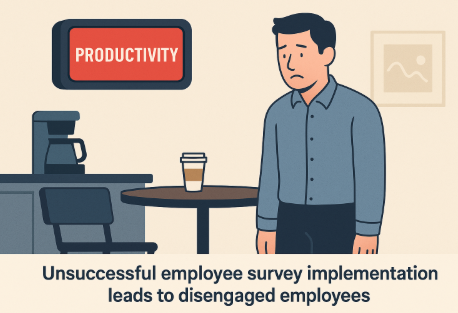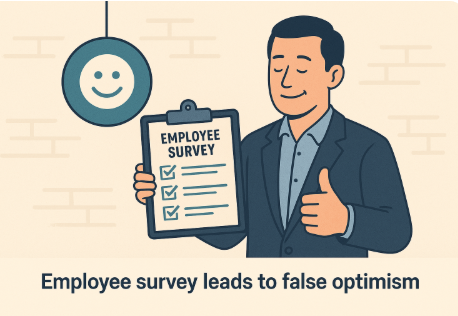Employee survey implementation is often seen as a best practice for improving workplace engagement and productivity. But many organizations collect data without a real plan for what comes next. When surveys are conducted but not acted on, employees lose trust, and leaders lose credibility. In this article, we’ll look at two real-world examples of companies that got it wrong—and what it takes to get it right.
Company A: A Productivity Counter Without a Purpose
In Company A, the leadership team was proud of its commitment to data. They had installed a live productivity counter in the employee break room. The display lit up red when productivity was below expectations and green when targets were met. The idea was to create transparency and awareness. On paper, it sounded promising. But in practice? The results were disheartening.
“I don’t even know what color it turns when we do meet productivity,” said one employee. “It’s always red.”
This employee had been with the company for over five years. Not once had he seen the light change color. To him, the red display became less of a productivity motivator and more of a perpetual shaming device. It silently communicated, You’re always falling short.

Even more concerning, the company conducted multiple surveys annually to gather employee feedback. But according to the employee, the surveys didn’t feel relevant:
- No one followed up with the results.
- No changes were ever implemented.
- There was no discussion of survey insights in team meetings.
Over time, employees began to lose sight of the point. The surveys became background noise, just another checkbox in a system that clearly wasn’t built to listen to them.
Company B: Honest Feedback, Unwanted Truth
Company B also ran surveys—two every year. And unlike Company A, employees took the time to provide thoughtful, honest responses. They genuinely hoped leadership would listen.
But year after year, the results stayed the same. Productivity was low. Engagement scores slipped. Employees voiced concerns about workload, unclear direction, and burnout.
The leadership’s response?
Blame the employees.
They accused staff of negativity, poor work ethic, and a lack of team spirit. Instead of seeing the surveys as a diagnostic tool, they treated them as an indictment of the workforce. As a result, a rift formed:
- Employees felt scapegoated and silenced.
- Leaders felt unappreciated and defensive.
- Surveys were completed with increasing reluctance—some even skipped them altogether.
The survey process had turned into a cycle of mistrust, where both sides resented the tool that was supposed to bring them closer together.

Where Employee Survey Implementation Went Wrong
Both organizations had the tools— the metrics, the surveys, and the intent. But they lacked the structure and mindset needed to make those tools effective.
| Mistake | Company A | Company B |
|---|---|---|
| Misuse of metrics | Focused on red light visibility, no positive reinforcement | Ignored trends in feedback |
| No follow-through | Surveys were collected but not acted on | Honest feedback led to blame instead of improvement |
| Erosion of trust | Employees are disengaged from the system | Employees felt punished for telling the truth |
| Leadership blind spots | Focused on visible metrics only | Refused to accept ownership of survey results |
The Fix: Turn Surveys Into Strategy
When data becomes divisive instead of directive, it’s time for a reset.
What both organizations needed wasn’t more surveys—it was a neutral, outside voice to help make sense of them. A Productivity Advocate can:
- Diagnose productivity holistically—not just with metrics, but with context.
- Uncover blind spots in leadership and communication styles.
- Build trust with employees by following up on feedback.
- Design a feedback loop that doesn’t just collect but uses it.
- Create a culture of accountability—without blame.
Final Thought
Data doesn’t change organizations. People do. And when surveys are used as a symbolic gesture instead of actionable insights, employees notice—and disengage. However, with the right process, leadership mindset, and guidance, even a broken system can be made productive again.
Because in the end, the problem isn’t that companies do surveys.
The problem is what they fail to do afterward.
Image Credits
OpenAI. (2025, June 11). Unsuccessful employee survey implementation leads to disengaged employees [AI-generated image]. Created using ChatGPT by OpenAI.
OpenAI. (2025, June 11). Employee survey implementation strategy for lasting productivity improvement [AI-generated image]. Created using ChatGPT by OpenAI.

